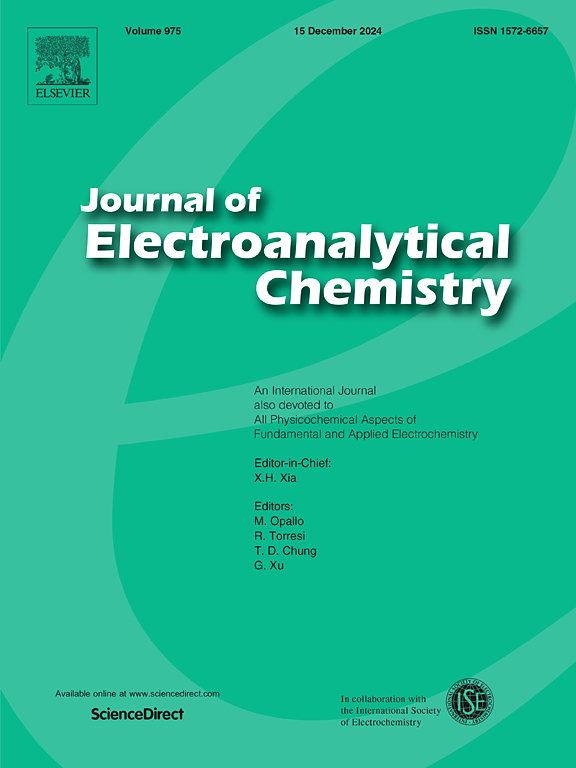氟掺杂对Nb2O5电催化生成H2O2性能的影响
IF 4.1
3区 化学
Q1 CHEMISTRY, ANALYTICAL
引用次数: 0
摘要
氧还原反应(ORR)是在温和条件下制备过氧化氢(H2O2)的有效途径。本研究考察了氟掺杂氧化铌(Nb2O5)纳米颗粒在不同摩尔比(0、0.005、0.01、0.02)下对Vulcan XC72碳的改性。采用氧化过氧化物法合成掺f的Nb2O5纳米颗粒,并通过浸渍将其掺入Vulcan XC72碳中。表征技术包括x射线衍射(XRD)、扫描电子显微镜(SEM)、透射电子显微镜(TEM)、接触角测量和x射线光电子能谱(XPS)。通过旋转环盘电极法的电化学评价表明,掺1.0% f的Nb2O5修饰的Vulcan XC72具有最佳的ORR性能。当用作气体扩散电极时,该电催化剂在所有应用电位下都比纯的和nb2o5修饰的Vulcan XC72碳产生更多的H2O2。在−0.7 V和−1.3 V电位下,该电催化剂的H2O2产率分别比nb2o5修饰的电催化剂高65%和98%。此外,与本研究比较的其他电催化剂相比,它具有更低的能耗和更高的电流效率。F掺杂增加了Nb2O5的晶格畸变和无序性,提高了ORR的电子可用性。此外,掺f的电催化剂表现出更多的含氧物质和更强的亲水性,促进O2的吸附、传输和电子转移。这些特性显著提高了H2O2的发电效率,同时降低了能耗。本文章由计算机程序翻译,如有差异,请以英文原文为准。

Effect of fluorine doping on the electrocatalytic properties of Nb2O5 for H2O2 electrogeneration
The oxygen reduction reaction (ORR) via the 2-electron mechanism is an efficient way to produce hydrogen peroxide (H2O2) under mild conditions. This study examines the modification of Vulcan XC72 carbon with fluorine (F)-doped niobium oxide (Nb2O5) nanoparticles at varying molar ratios (0, 0.005, 0.01, 0.02). The F-doped Nb2O5 nanoparticles were synthesized using the oxidizing peroxide method and then incorporated into Vulcan XC72 carbon via impregnation. Characterization techniques included X-ray diffraction (XRD), scanning electron microscopy (SEM), transmission electron microscopy (TEM), contact angle measurements, and X-ray photoelectron spectroscopy (XPS). Electrochemical evaluation using the rotating ring disk electrode method revealed that Vulcan XC72 modified with 1.0 % F-doped Nb2O5 exhibited the best ORR performance. When used as a gas diffusion electrode, this electrocatalyst produced more H2O2 at all applied potentials than the pure and Nb2O5-modified Vulcan XC72 carbon. At potentials of −0.7 V and −1.3 V, the proposed electrocatalyst achieved H2O2 yields 65 % and 98 % higher than the Nb2O5-modified electrocatalyst. Furthermore, it presented lower energy consumption and higher current efficiency than the other electrocatalysts compared in this study. The enhanced performance is attributed to F doping, which increased Nb2O5 lattice distortion and disorder, improving electron availability for ORR. Additionally, F-doped electrocatalysts exhibited more oxygenated species and greater hydrophilicity, facilitating O2 adsorption, transport, and electron transfer. These properties significantly enhanced H2O2 electrogeneration efficiency while reducing energy consumption.
求助全文
通过发布文献求助,成功后即可免费获取论文全文。
去求助
来源期刊
CiteScore
7.80
自引率
6.70%
发文量
912
审稿时长
2.4 months
期刊介绍:
The Journal of Electroanalytical Chemistry is the foremost international journal devoted to the interdisciplinary subject of electrochemistry in all its aspects, theoretical as well as applied.
Electrochemistry is a wide ranging area that is in a state of continuous evolution. Rather than compiling a long list of topics covered by the Journal, the editors would like to draw particular attention to the key issues of novelty, topicality and quality. Papers should present new and interesting electrochemical science in a way that is accessible to the reader. The presentation and discussion should be at a level that is consistent with the international status of the Journal. Reports describing the application of well-established techniques to problems that are essentially technical will not be accepted. Similarly, papers that report observations but fail to provide adequate interpretation will be rejected by the Editors. Papers dealing with technical electrochemistry should be submitted to other specialist journals unless the authors can show that their work provides substantially new insights into electrochemical processes.

 求助内容:
求助内容: 应助结果提醒方式:
应助结果提醒方式:


